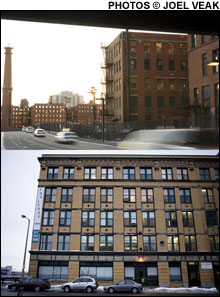Shen, of the BRA, says that the letters shouldn't be interpreted to mean that the artists will be out on the street at the end of next month, but at the same time he underscores the urgency of getting the artists out of buildings for which Archon has no immediate plans. "People really don't have other options in the building," says Shen. "The fire marshal wants it vacated as soon as possible."
Is that a smoke screen? In citing fire safety, Shen echoes claims made by Archon: that there is no way of making necessary modifications as long as there is one soul in the building. Tenants refute this, saying fire alarms were installed after a protracted fight between inspectors and Archon, during which a fireman had to be stationed outside the building for several months, until the spring of 2008, presumably to alert the department in the event of a fire. There is no record of 337 Summer Street currently being in violation of the fire code, according to files kept by the Inspectional Services Department (ISD). Neither the Boston Fire Department nor ISD responded to repeated queries about the building.
Despite the confusion and concern raised by the BRA's plan and Archon's letters, Shen insists work should be getting underway any day now on the temporary studios, saying, "We think we're going to immediately jump-start construction work."

BAIT AND SWITCH: Rather than move temporarily from one building (337 A Street, bottom) to another (319 A Street, top), with the potential for another move looming in two years, many Fort Point artists have packed up and left the neighborhood for good. |
State of the arts
In defending Boston's commitment to artists, city officials point to efforts it has made citywide, through its Artist Space Initiative, begun eight years ago to create units "permanently dedicated" to artists. The BRA estimates it has created around 200 units since the program began, many of them cobbled on as the affordable units in market-rate projects.The program's proudest moment came with the opening of Midway Studios in Fort Point, an 89-unit rental building on Midway Street completed in 2005, which many artists acknowledge was the rare case when the city was able to prevail upon a developer to give up a building, or at least provide a 50-year lease. Artist space-advocacy groups have pushed for projects like Midway — large artist-only buildings owned or controlled by nonprofits or co-ops — around the country. In fact, 249 A Street in Fort Point, which has been owned by artists since 1983, has served as a national model.
The city, however, has shown a clear preference to work with private developers in creating artist units. When it comes to the tensions in Fort Point, the city has lately pointed to the Westinghouse project in Hyde Park (where, Menino's spokeswoman points out, our arts-loving mayor lives). The complex is being converted by a private developer into 62 artist live/work condos.
The project is ambitious, not least because condos aren't exactly selling like hotcakes these days — and artists may have as hard a time as anyone getting financing. At the same time, when the city zoning board approved the project in 2007, at the urging of the BRA, it agreed that the units could be sold to non-artists if, after a "good-faith marketing effort," units remained unsold. A similar policy prevails at other buildings, including ArtBlock, in the South End, where at least two artist units have gone to non-artists.
In any case, critics point out, the number of units created citywide does not equal the number of units that have been lost in Fort Point alone over the past decade. And if the city can't protect artists from being bullied around by an out-of-town corporate developer, in the very neighborhood proclaimed to be New England's "largest and oldest" artist community, what does it say about the effectiveness of its efforts?
"Boston is in trouble," said Bernstein of FPAC during a dusk-time stroll through Fort Point, as office workers hurriedly made their way down Summer Street to parking lots and over the bridge into downtown. "So much of the planning here has been market driven and piecemeal."
For him, the changes in Fort Point have been personally disillusioning. "I remember coming out here and being intimidated, because this was where the real artists were," recalls Bernstein of his art-student days at the Museum School in the early '90s. The neighborhood, he says, has since lost its mystique.
"An artist visiting from New York asked me, 'Where's Boston's Brooklyn?'" he recalls. "I said, 'We don't have one.' "
Ted Siefer is a Boston-based journalist. He can be reached at tedsiefer@me.com.